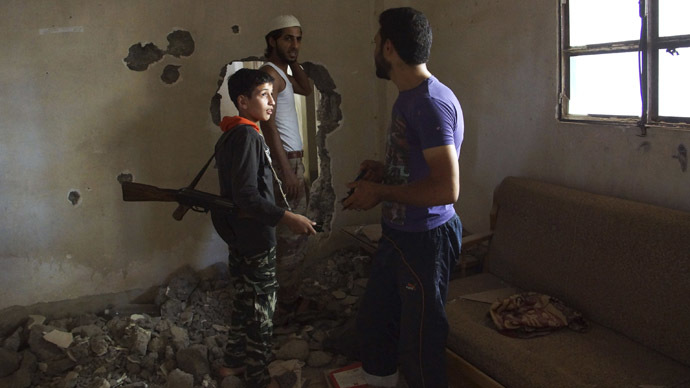Kids on the Front Lines

Dany, a 14-year-old fighter, whom activists say is the youngest fighter in the Khadraa brigade operating under the Free Syrian Army. Picture by Khalil Ashawi | Reuters

[Originally posted here]
Because of manpower shortages, the Syrian conflict has given rise to yet another distressing phenomenon: child soldiers.
Although all factions in the Syrian conflict have recruited child soldiers, it is unclear if formal units composed solely of minors (individuals under the age of 18) have been formed by any of the armed factions in the war, with the possible exception of the Islamic State group (also known as ISIS). Outside of the Islamic State group, minors fighting in the conflict often do so within irregular formations that lack normal rank structures, or were active in pre-war youth associations that have since become militarized. Many simply volunteer.
Some minors are in family units fighting alongside one another. Most of these units are not affiliated with any particular side and are usually formed to defend a district from marauding pro- and anti-regime forces. Other minors fight alongside older relatives. Most, however, seem to have been separated from their immediate family by the time they have joined up. These are the conscripts most at-risk for physical and sexual abuse, or being forced into criminal activities by their elders, running from petty theft to torture of POWs.
The total number of child soldiers involved in the war is unknown. Around 200 child soldiers have been confirmed killed in action by rights groups over the past four years. Although this figure represents about 2 percent of all casualties among Syrian children since 2011, the real number is likely far higher.
Although children under the age of 18 are less often used as frontline combatants, younger adolescents (ages of 13 to 17), usually males, may be employed as spies, guards for low-security sites, canteen workers or smugglers. Human rights groups suggest that even 14- and 15-year-old combatants are not unknown in rebel-held areas. Part of the appeal is the money: A child soldier can draw a relatively good wage in the warzone.
Historically, teenagers have held positions in conditions that many adults would retreat from. Although they can be trained to use most small arms and light weapons competently, children under the age of 12 are least likely to be encountered under arms because they are too small and too dependent on adult supervision to be effective militarily. But, as the Syrian conflict proven, such young children are not unknown among the ranks.
Though the Syrian opposition officially regards child soldiering as an unfortunate consequence of war beyond its control, it is clear that some anti-regime groups assiduously recruit minors. Training centers exist as combination boot camps and political indoctrination centers, more so among the Islamist factions of opposition.
Other sides of the conflict, including the Syrian Arab Army and affiliated militias, have conscriptedindividuals under the age of 18 for frontline service as well. Considering the massive losses in trained personnel that the Syrian armed forces have sustained since 2011, these forces would need to be calling up younger and younger class years in order to fill out their ranks. Poorer recruits, whether of-age or minors, are more at risk than well-off ones, because those who can afford to will pay off recruiters in exchange for deferments. Those who cannot pay must go into hiding, flee or go to war. Deferment priceshave risen exponentially in recent years, so even the moderately well-off cannot escape.
Kurdish forces, such as the People’s Protection Units, have also allowed minors to sign up without parental consent. Although Kurdish officials speak of the heroic sacrifices of these children, they are not particularly enthusiastic about these measures since it underlines their irreplaceable losses of seasoned fighters after years of fighting against other militias and hostile governments.
Due to unexpected losses taken in Syria, Hezbollah will now accept minors for frontline service. For a while, Hezbollah was the only armed faction that emphatically did not use child soldiers in Syria. Despite maintaining a large paramilitary youth wing and actively ministering to Shiite refugees within Lebanon, only its most experienced or politically reliable fighters were allowed to fight on behalf of the Assad regime. Hezbollah’s ally, Iran, uses financial pressure and the promise of resettlement to recruit Afghan refugees as “disposable” combatants, but it is unclear if any minors have volunteered for service in Syria. There is a risk of this occurring, however, since the targeted population consists of refugees with limited personal documentation vulnerable to coercion.
Though the forces affiliated with the Free Syrian Army, Kurdistan Workers’ Party, the People’s Protection Units and the Kurdish Regional Government in Iraq have all pledged to reduce their recruitment of minors, the Islamic State group shows no such restraints. Its child soldiers are often local volunteers who feel inspired to join. This was, at least, the case earlier in the war — now more of these “recruits” appear to be conscripts or children whose families feel they have no choice but to pass off another hungry mouth onto the Islamic State group in exchange for financial subsidies awarded to recruits’ families. Others have simply been kidnapped. The group indoctrinates child soldiers to perform suicide operations, tortures them as part of their “training,” and even forces them to participate in POW executions. This is comparable to the initiation practices pursued by the Lord’s Resistance Army or the Revolutionary United Front. Like these groups, the Islamic State group hopes to brainwash the recruits by building their commanding officers up as parental figures through supervised bloodletting, and to discourage the children from deserting by making them complicit in war crimes.
Even Europe has begun to feel the effects. Since the beginning of the conflict, hundreds of minors in Europe, most of whom are from Muslim and Arab diasporas there, have attempted to travel to the region to fight as child soldiers against the Syrian regime. Those that have made it over usually turn out to have been shanghaied by prostitution rings that simply used the war as a lure. Those who do make it to the ranks of a militia can end up as “comfort women” (and men), essentially “war brides” for the Islamic State group.
While some safeguards have been implemented to reduce the deployment of child soldiers, minors will continue to volunteer and to be deployed to the frontlines so long as the war continues. By providing greater support to refugee communities, international donors and governments can reduce the financial incentive for such courses of action.
Paul Mutter is a graduate student at NYU pursuing an MA in International Affairs. He is a blogger for the Foreign Policy Association, and also writes for War Is Boring, The Arabist and Souciant Magazine.






